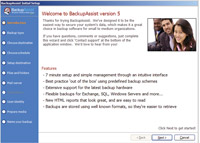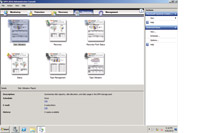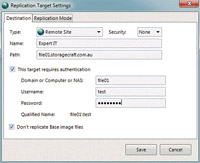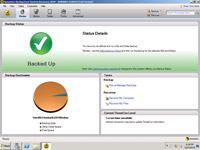Redmond Roundup
Review Round-Up: Data Protection and Recovery Products
Backup software has come a long way in recent years. We compare four products that should prove useful, particularly for small to midsize enterprises.
Backing up applications, servers and sometimes client computers is a necessary evil in IT, both to protect against disasters and to guard against user error. In small to midsize businesses (SMBs), this chore can become a huge burden unless the chosen backup solution is both comprehensive and easy to use. SMBs don't have the luxury of a dedicated backup person or team, so an ideal backup solution should cover all workloads, be easy to use and, above all, be failsafe when the judgment day arrives and the restore has to work.
In this roundup, we compare four popular backup solutions for SMB IT environments: Microsoft System Center Data Protection Manager (DPM) 2010, Cortex I.T. BackupAssist (BA) version 5.4.5, StorageCraft Technology Shadow Protect (SP) version 4 and Symantec Backup Exec System Recovery (BESR) 2010.
Each product was installed and configured on Windows Server 2008 R2 and used to back itself up; each product also backed up an Exchange 2010 server. We assessed how smooth the installation went and how easy it was to configure scheduled backups, as well as general ease of use.
Backups center around two concepts: Recovery Time Objective (RTO), a definition of how quickly a service needs to be restored to the business, and Recovery Point Objective (RPO), which defines the acceptable data loss in time. Both should be defined by the business -- not IT -- and together they should answer the questions: "How long should it take to get this back up and running?" And, "How much data can we afford to lose?"
BackupAssist 5.4.5
Installation of BA is a breeze: To set up, simply run the setup program and click "next" a few times. Once the product is installed (a reboot is required in order to install the open-files components), clicking the shortcut on the desktop takes you to the main configuration. Somewhat uniquely, BA relies on Windows Backup components to perform backups.
To do image-based backups, for instance, I had to install the Windows Backup feature so that the Microsoft Block Level Backup Service became available. For Windows 2003 and earlier platforms, BA uses Microsoft NTBackup in the background.
External (including RDX and REV) and local drives are all supported, as are network shares -- a feature Windows Server Backup only offers in 2008 R2. Setting up a file-based backup is easy with a wizard that offers different types of media schemes (grandfather/father/son, and so on). You should run Windows image backups at least an hour apart, with no more than four backups a day; other backup methods run daily.

[Click on image for larger view.] |
| Figure 1. BackupAssist relies on Windows Backup components to perform backups. |
Both Exchange and SQL Server are supported by Backup Assist, but you should be aware that individual mailbox restores are supported through Microsoft Exchange Server Mailbox Merge Wizard (ExMerge), which limits mailbox sizes to 2GB. There's a documented way to work around the 2GB limit by installing Outlook on the BA server. SQL databases can be backed up locally and over the network to a central location; backups can be made as often as every 15 minutes. The upcoming version 6 of BA will offer fully integrated Microsoft Visual SourceSafe (VSS) application backup of Exchange, SQL Server, SharePoint and Hyper-V.
Another interesting option in BA is tape backup support for Windows Server 2008 and R2, something that's not supported in the built-in Windows Server Backup. For Hyper-V backups, a single backup of the host can be used to mount individual .VHD files for granular restores of individual files. BA has implemented the open ZIP64 format for its backups for long-term accessibility of the archived data. BA allows backups to be sent to FTP servers (including secure FTP) and Rsync servers; there's even an option to use Amazon S3 Cloud storage for Rsync. SMB IT providers can configure one or more NAS units with Rsync and sell backup services to their clients.
BA is easy to set up and use; it's perfect for a small environment with a few servers. It doesn't have an agent/central server architecture, however, so if you have several application servers -- Active Directory (AD), SQL, Exchange and SharePoint, to name a few -- to back up, each will need the product installed and its own backup media setup. There's an option to centralize monitoring for several BA installations.
Microsoft System Center Data Protection Manager 2010
Now in its third incarnation, DPM has grown to be a serious contender for backing up all Windows-based workloads in an efficient and reliable manner. DPM 2010 requires a 64-bit instance of Windows Server 2008/2008 R2 and an agent installed on each server that needs protection. The agent software itself is identical, whether it's running on a file server, a client computer or an application server; it's only the licensing that differs. Installation is smooth, with a comprehensive wizard covering all prerequisites.
Once DPM 2010 is installed, you configure disk storage for storing backups; Disk-to-Disk (D2D) and Disk-to-Disk-to-Tape (D2D2T) for long-term archiving are both supported. In smaller environments where short-term removable disk-based backups are preferred, an affordable third-party add-on called FireStreamer enables backups directly to removable disks such as USB, Firewire and eSata.

[Click on image for larger view.] |
| Figure 2. Data Protection Manager 2010 supports policy-based backups of client computers. |
Once DPM 2010 knows where to store backups, you configure Protection groups, which can include one or more data sources on one or more servers. These will then share a common schedule and settings; for example, marketing's file shares, SharePoint data and an Exchange database can all be backed up together. Backups can be made as often as every 15 minutes.
As expected, DPM 2010 protects all major Microsoft workloads, including Exchange 2010 (with full support for Data Availability Groups), SQL Server, SharePoint 2010 and Hyper-V (covering the new SAN functionality in 2008 R2, Clustered Shared Volumes). DPM 2010 improves on its predecessor in various ways: data co-location makes more efficient use of disk space, and automatic consistency checks are performed when a replica is inconsistent. If a data source grows unexpectedly, DPM 2010 will automatically increase the allocated storage space, and if a particular file fails, DPM 2010 will continue the backup job and report the failure at the end.
New in DPM 2010 is policy-based backup of client computers, allowing selected folders on desktops and laptops to be seamlessly replicated back to the DPM 2010 server.
For true "offsite" backups, DPM 2010 servers can protect each other over a WAN link, with data compression over the wire. Backup storage in the cloud is an option through a partnership with Iron Mountain Inc.; there's also an appliance from i365 Inc. (a business unit of Seagate Technology LLC) that runs DPM 2010 and can back up to the cloud.
The strength of DPM 2010 lies in its "understanding" of Microsoft workloads.
Integrating deeply with Exchange, SQL Server and SharePoint, along with other applications, it offers a deceptively simple interface that makes it easy to both back up and restore data. It can even integrate with AD so that end users can use the Previous Versions tab to recover data directly from the DPM store.
One downside to DPM 2010 is that the bare-metal restore tool, System Recovery Tool for Windows 2003 and earlier, is a separate program with a different UI than the main DPM console, and it uses a different data storage pool.
DPM 2010 can't be recommended for single-server environments, as you really need a separate server for it -- though it can be virtualized. For anything larger running Microsoft workloads, however, DPM 2010 is an excellent choice.
ShadowProtect 4
The new version of SP offers several compelling features. Installation is again a simple click-through operation. Backups in SP are image-based, using the underlying VSS technology in Windows Server and providing very fast backups after the first full backup, as only changed sectors are backed up. Backups can be made as frequently as every 15 minutes. In the Image manager, existing backups can be converted to several VMware formats, as well as to .VHD format for Microsoft Hyper-V.
A very interesting disaster recovery option is the built-in VirtualBox wizard; this lets you boot a backup image of the failed server in Sun VirtualBox in just a few minutes, providing excellent RTO times. The task of pushing out SP from a central server to each machine that needs backup, as well as monitoring the status of backups, can be performed in the new Management View.

[Click on image for larger view.] |
| Figure 3. The ShadowProtect 4 console lets administrators set backup targets. |
It's important to realize that the central server isn't a central control server with agents talking to it; it's just a file server, where multiple other servers store their backup. Should that central server fail for some reason, backups can simply be redirected to another storage location.
Backup images (both full and continuous incremental ones) can automatically be consolidated into daily, weekly and monthly images for archiving. If an image file is detected as corrupt, the next backup will automatically be a differential image going back to the last good backup.
Backup images can be stored on local drives (including removable drives), network locations (any UNC path, including remote sites if bandwidth allows) and remote sites.
Storage at remote sites, an extra $299, transfers backups using binary chunks to an FTP server for true offsite backup storage.
SP is a comprehensive product, offering efficient backups and smoothly blending the physical and virtual worlds for easy disaster recovery. The lack of an agent-based architecture might be an issue in larger environments, but this new version is already in production in a company with 87 servers, according to ShadowProtect Australia. SP is proving to be suitable for all SMBs.
Symantec Backup Exec System Recovery 2010
There was once an excellent image-based backup program by the name of v2i from PowerQuest, which was eventually acquired by Symantec Corp. and renamed Livestate Recovery (as was a popular backup product from Veritas Software Corp. called Backup Exec, which Symantec also acquired). The latest incarnation of this product from Symantec is BESR.

[Click on image for larger view.] |
| Figure 4. Backup Exec System Recovery 2010 provides centralized server control. |
Installation of BESR is smooth, with a reboot requested at the end. Defining a backup job of the local server is easy. Offsite Copy allows a second copy of the data to be housed elsewhere (FTP), providing robust disaster recovery. Backups can be made every 15 minutes. Unlike the other products in this roundup, BESR runs on Linux (RHEL5, SLES 10) as well as on Windows. The Virtual Edition allows installation of BESR in all virtual machines (VMs) on a single host with just one license.
BESR is part of the larger Backup Exec family and integrates with Backup Exec for a combination of image backups for disaster recovery and file-based backups for file and application recovery. D2D2T is supported in this configuration with both the BESR image backups and the Backup Exec file backups automatically moved to tape after a configurable amount of time. BESR Manager offers centralized control across multiple servers. Converting backup images to VMs is easy, with a scheduler for recurring jobs that can convert to VMware workstation .VMDK files, ESX server-compatible VMs or Microsoft .VHD files.
Exchange data can be restored at the e-mail, folder and mailbox levels; individual SharePoint data can also be restored. Google Desktop can be used to index files and Backup Exec Retrieve offers an end-user interface for simple file recovery.
The main strength of BESR lies in its integration with other products in the Symantec line, particularly Backup Exec, as well as in offering cross-platform support for the Linux world. You can even configure BESR to run a backup job when the Threatcon level (the Symantec measure of dangerous malware activity) increases.
| REDMOND
RATING |
|
Backup Assist 5.4.5 |
System Center Data Protection Manager 2010 |
Shadow-Protect 4 |
Backup Exec System Recovery 2010 |
Installation:
20% |
8 |
8 |
9 |
8 |
Features:
20% |
7 |
9 |
8 |
8 |
Ease of Use:
20% |
7 |
8 |
8 |
7 |
Administration:
20% |
7 |
9 |
8 |
7 |
Documentation:
20% |
8 |
9 |
9 |
8 |
Overall
Rating: |
7.4 |
8.6 |
8.4 |
7.6 |
Key: 1: Virtually inoperable or nonexistent 5: Average, performs adequately 10: Exceptional
|
|
|
Four Strong Products
Set-and-forget backup software has come a long way in the last few years. All four of the products covered here will serve SMBs well for easy data protection. One trend to note in these products is that backup to the cloud is gaining momentum as bandwidth increases. Virtualization is also permeating backup, allowing the backup of VMs with just an agent in the host, as well as offering easy restores of servers as VMs.
The other trend is that all these products rely heavily on VSS, which shows that this built-in technology really improves backups across Microsoft platforms and apps. This also means that when VSS plays up, backups don't work as expected.
BackupAssist version 5.4.5
$249 for a server license;
$249 for the virtual machine granular restore add-on
Cortex I.T. Labs | 812-206-4265 | Backupassist.com
System Center Data Protection Manager 2010
Server license $579; application agent license $431
Microsoft | 800- 642-7676 | Microsoft.com/dpm
ShadowProtect version 4
Server license $995; $495 Small Business Server;
$299 ImageManager Enterprise
StorageCraft Technology Corp. | 801-545-4705 | Storagecraft.com
Backup Exec System Recovery 2010
Pricing starts at $891.20 for a server license
Symantec Corp. | 800-745-6054 | Symantec.com